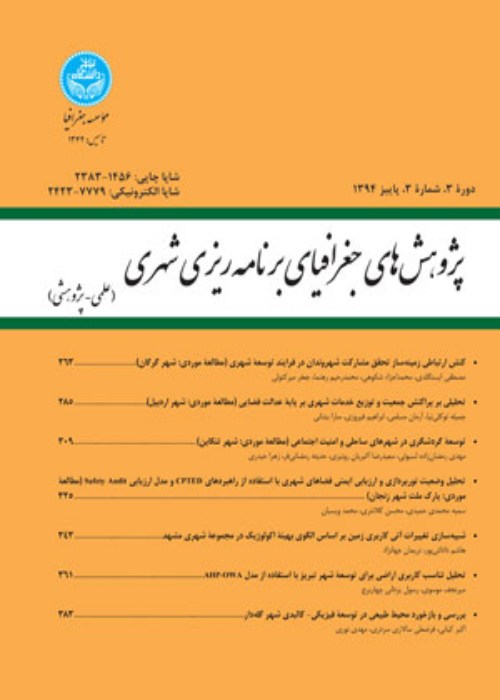Analysis of the morphological structure of urban network in Khuzestan province
Analyzing the structure and morphological patterns of the urban network has a fundamental role in the understanding of the population distribution process and the communication and service patterns of the urban system in the regional area. Considering this importance, in this research, an attempt has been made to analyze the morphological structure of the urban network in Khuzestan province. Analytical indicators of the research are to identify the structure and morphological patterns of the distance of population nodes and the hierarchy of the communication network in the Khuzestan province. Net draw and Uci NET flow and network analysis software were used for data analysis. The results show that based on the distance index of population nodes in the province, the morphological pattern of the urban network is linear-circular, radial and network. Meanwhile, according to the intra-regional communication network index, the dominant pattern of the urban network is linear-circular, which forms a network pattern by increasing the functional range of the communication network. The results of the research show that the majority of the urban network in Khuzestan province is small and medium in size and in close distances they have a linear morphological pattern, and with the increase in the distance of geographical centers and the functional scope of the communication network due to the presence of several dominant cities such as Ahvaz and Dezful, A network pattern is formed around the axis of these cities in the morphology of the urban network of the province
Investigating the morphology of the urban network in a geographical space is done in the framework of achieving the goal of balancing the land use. As the center of concentration of population, capital, flow of goods, services, innovation, etc., cities play an important role in planning as an element of space balance in regional and national scales. The balanced organization of space is possible with the scientific understanding of urban network morphology because the organization of spatial forms is formed through urban communication at different spatial levels. The urban network of Khuzestan province has been formed on the basis of different environmental, economic and social diversity. The existence of various spaces has caused diversity in the function and role of cities (port, commercial, basic energy industry) of the province. In this regard, the dispersion of cities in the macro-geographical level along with the diversity in role and function has affected the urban morphology. In this research, by analyzing the morphological structure of the urban network of Khuzestan province based on the variables of the distance between the population nodes and the communication network, the relationship between the types of morphological patterns and the performance of the cities is discussed.
This research is practical and has been done with "descriptive-analytical" method. The data has been collected from library documents and data, providing at the provincial and national institutions. To draw and analyze the morphology of the Khuzestan urban network in two separate parts, the communication network index based on service-based relationships as well as the distance of population nodes (cities) in the spatial area of Khuzestan province has been used. To analyze the data and draw the morphology of the urban network of the province in two dimensions of the communication network and the distance of the nodes from three Gower functions; Closeness and Varimax have been used in UciNET and Net Draw software.
In the findings section, the morphological patterns of the urban network of the province were analyzed based on the distance of population nodes in three radii of 10, 30 and 50 km, based on which it was determined that the reason for the formation of the linear pattern is due to the small size of the cities. It is mostly seen in the central, western and southern parts of the province. In this pattern, the absence of dominant cities near small cities is influential, which is an important reason for the formation of a linear pattern in the near distance for the cities of Khuzestan province, which are mostly small in size. In the analysis of urban network morphology based on the distance between nodes, network and ring patterns have been formed when dominant cities such as Ahvaz and Dezful metropolises have played a role in the urban network structure and the morphological structure of the urban network of the province. In the formation of the linear-circular pattern, the main factor was the large distance between the cities of the province in the central, northern and southern and western-eastern parts.
In the analysis of urban network morphology based on intra-provincial communication network, three radii of 30, 50 and 80 km were considered and analyzed. In the analysis of urban network morphology based on intra-provincial communication network, three radii of 30, 50 and 80 km were considered and analyzed. Similar to the node distance index, in the communication hierarchy index, in close distances, most of the cities have found a linear pattern due to their small size, and their morphological ring is due to the existence of dominant cities such as Ahvaz, Dezful and Ramshir, which are nearby cities. To them, they obey them in communication interactions as communication nodes. As the distance increases, network polygons in all four corners of the province with dominant cities such as Ahvaz, Dezful, Abadan and Bandar Mahshahr and connecting cities such as Hamidiyeh, Shush, Shushtar, Andimshek and Suleiman Mosque and Behbahan form the morphology of the urban network of the province. They give a grid shape.
The results of this research using the mentioned two indices, i.e. the distance between population nodes and the intra-regional communication network pattern, showed that from the point of view of focal waste index or geographical nodes, based on the dominant patterns in the theoretical literature presented for urban network morphology, three dominant morphological patterns were obtained in the urban network of Khuzestan province, which were linear-circular, radial and network patterns. While from the point of view of the communication network pattern index, the dominant morphological pattern for the urban network of the province was linear-circular, which with increasing the functional radius of the communication network, a network pattern is formed in the morphology of the urban network of the province. Examining the existing approaches and the background of the research shows that the best model for evaluating successful urban morphology is a network model with strong and synergistic links of two-way and multi-way interactions between the urban network, and the weakest morphological models are linear and radial models or center around It is a sign of the hierarchy and centrality of the structure, communication and function of the cities of a region. In this regard, a finding of this research made it clear that multi-dimensional and multi-functional interaction is not dominant in the urban network of Khuzestan province, and strong nuclei such as Ahvaz and Dezful form a circular pattern to meet needs and demand, and a linear pattern is also the pattern that governs relations and The communication between the small cities of the province is in close and even medium distances, and this type of pattern itself shows the poverty of having a proper, complementary and decisive position for the cities of the province to take an interactive, service and communication role suitable for themselves and their sphere of influence. Considering the importance of studying the structure, function and morphological patterns of the urban network in regional development and its role in the analysis and development of approaches based on sustainable land use, the present study from a morphological point of view was able to, according to the available data, based on Indexes of node distance and communication network to analyze the urban network of Khuzestan province. In this regard, future studies can analyze the urban network of the province and the interactions and functions of the urban network by relying on more and more diverse indicators such as the role of physical structure and also the pattern of dominant activities in the regional area.
- حق عضویت دریافتی صرف حمایت از نشریات عضو و نگهداری، تکمیل و توسعه مگیران میشود.
- پرداخت حق اشتراک و دانلود مقالات اجازه بازنشر آن در سایر رسانههای چاپی و دیجیتال را به کاربر نمیدهد.




